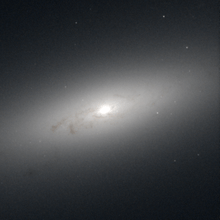NGC 4550
NGC 4550 is a barred lenticular galaxy located in the constellation of Virgo that can be seen with amateur telescopes. It lies at a distance of 50 million light-years (15.5 mega parsecs) from the Milky Way and is a member of the Virgo Cluster.[2]
| NGC 4550 | |
|---|---|
 | |
| Observation data (J2000 epoch) | |
| Constellation | Virgo |
| Right ascension | 12h 35m 30.6s[1] |
| Declination | +12° 13′ 15″[1] |
| Redshift | 381 ± 9 km/s[1] |
| Distance | 50.0 Mly |
| Apparent magnitude (V) | 12.2[1] |
| Characteristics | |
| Type | SB(s)00[1] |
| Apparent size (V) | 2′.85 × 0′.82[1] |
| Other designations | |
| UGC 7757,[1] PGC 41943, VCC 1619[1] | |
Physical characteristics
While NGC 4550 is not one of the brightest galaxies of the Virgo Cluster, it is notable as it is one of the few galaxies where a large amount of its stars rotate around the galaxy's center in opposite direction to the others[3][4]
About her research article on this galaxy, Vera Rubin wrote: "I discovered from observations of NGC 4550 that in the single disk of this galaxy, half the stars orbit clockwise, and half the stars orbit counterclockwise, both systems intermingled. This observation required that many astronomers modify the manner in which they measured velocities, for computer programs were not then equipped to handle such complexity." She mentions and takes pleasure in the fact that the discovery was made at age 63.
Another, brighter, example is the spiral galaxy NGC 7217. The stars of this galaxy are concentrated in two disks of similar size and surface brightness, one nested within the other[4] and it has been suggested it's the product of the merger between two previous disk galaxies, each one counter-rotating with respect to the other.[5]
NGC 4550's center also shows a small amount of molecular hydrogen and interstellar dust,[4] the latter concentrated in a disk surrounding its core[6] where star formation is taking place albeit at a very modest level.[5]
References
- "NASA/IPAC Extragalactic Database". Results for NGC 4550. Retrieved 2012-12-25.
- Mei, S.; Blakeslee, J. P.; Côté, P.; Tonry, J.L.; West, M. J.; Ferrarese, L.; Jordán, A.; Peng, E. W.; et al. (January 2007). "The ACS Virgo Cluster Survey. XIII. SBF Distance Catalog and the Three-dimensional Structure of the Virgo Cluster". The Astrophysical Journal. 655 (1): 144–162. arXiv:astro-ph/0702510. Bibcode:2007ApJ...655..144M. doi:10.1086/509598.
-
- Rubin, V.C.; Graham, J. A.; Kenney, J.D. P. (1992). "Cospatial Counterrotating Stellar Disks in the Virgo E7/S0 Galaxy NGC 4550". The Astrophysical Journal. 394: L9–L12. Bibcode:1992ApJ...394L...9R. doi:10.1086/186460.
- Wiklind, T.; Henkel, C. (September 2001). "Molecular gas and dust in NGC 4550. A galaxy with two counterrotating stellar disks". Astronomy & Astrophysics. 375 (3): 797–804. arXiv:astro-ph/0106286. Bibcode:2001A&A...375..797W. doi:10.1051/0004-6361:20010860.
- Crocker, A. F.; Jeong, H.; Komugi, S.; Combes, F.; Bureau, M.; Young, L. M.; Yi, S. (March 2009). "Molecular gas and star formation in the red-sequence counter-rotating disc galaxy NGC 4550". Monthly Notices of the Royal Astronomical Society. 393 (4): 1255–1264. arXiv:0812.0178. Bibcode:2009MNRAS.393.1255C. doi:10.1111/j.1365-2966.2008.14295.x.
- Mei, S.; Côté, P.; Jordán, A.; Peng, E.W.; Blakeslee, J. P.; Piatek, S.; Mei, S.; Merritt, D.; et al. (June 2006). "The ACS Virgo Cluster Survey. VI. Isophotal Analysis and the Structure of Early-Type Galaxies". The Astrophysical Journal Supplement Series. 164 (2): 334–434. arXiv:astro-ph/0602297. Bibcode:2006ApJS..164..334F. doi:10.1086/501350.
External links
| Wikimedia Commons has media related to NGC 4550. |
- Merrifield, Michael. "Star Motion in NGC 4550". Deep Space Videos. Brady Haran.